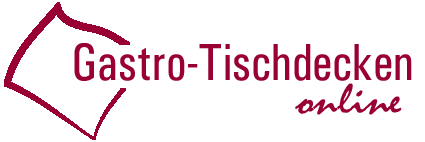Technical Terms and Definitions
Atlas Edge, Satin band The satin band is the shiny, mostly circumferential stripe, which is woven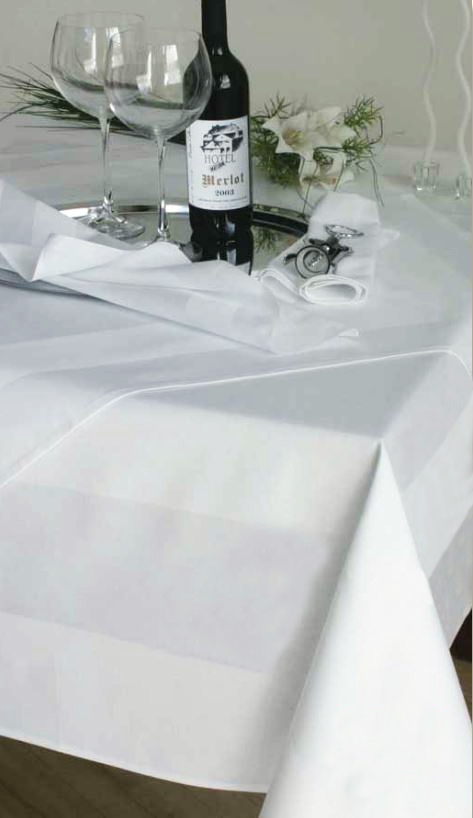 into the overhang of the tablecloth. The width of this strip varies, but is usually between 10 cm and 20 cm. Sometimes the atlas edge is also called satin band or atlas strip. The satin weave is one of the basic weaves of fabrics, along with the canvas and body weave. With the satin binding, the binding points are evenly distributed and do not touch each other, so that a more or less shiny, structure less surface is created depending on the type of fiber. This is especially nice for tablecloths and cloth napkins with atlas edge.
into the overhang of the tablecloth. The width of this strip varies, but is usually between 10 cm and 20 cm. Sometimes the atlas edge is also called satin band or atlas strip. The satin weave is one of the basic weaves of fabrics, along with the canvas and body weave. With the satin binding, the binding points are evenly distributed and do not touch each other, so that a more or less shiny, structure less surface is created depending on the type of fiber. This is especially nice for tablecloths and cloth napkins with atlas edge.
Banquet
A banquet is a feast or a big celebration. For this purpose, the tables are usually covered very festively with white gastronomy tablecloths.
Buffet
The buffet is firmly anchored in the catering supplies. This refers to a sideboard table or even a sideboard counter, which no hotel, restaurant or catering establishment should be without.
Candelabra
Candelabra is the name given to multi-armed candlesticks manufactured for the catering trade.
Catering
Many catering establishments also offer catering: This refers to out-of-home events. The catering company supplies the equipment: from the catering tablecloth and napkins to food and drink, everything is delivered as required and is dismantled again at the end of the event.
Chef de cuisine
In a restaurant or hotel, chef de cuisine is the person responsible for managing the kitchen.
Cocktail
A cocktail is a mixed drink. The cocktail is served in upscale restaurants with a cocktail napkin.
Cotton
Many tablecloths today are made from cotton, a natural fiber extracted from the seed hairs of cotton bushes. The fibers used for tablecloths are usually spun into thin threads and are highly absorbent. Cotton fabrics as a whole are skin-friendly and therefore extremely popular with allergy sufferers. Cotton fabrics and thus cotton tablecloths have numerous other positive properties, including high resistance of the tablecloths to mechanical and chemical influences, high tensile strength of the tablecloths, high wet strength and high abrasion resistance of the tablecloths. In addition, cotton is easy to clean, can be washed very hot (heat-resistant) even during numerous washing cycles and also has excellent dyeing properties. A yellowing occurs with dry cotton at approximately 160 degrees. Only at approximately 250 degrees, it becomes brown. Cotton tablecloths are appreciated mainly for their naturalness and pleasant fabric properties - unlike polyester tablecloths.
Covers
Covers are covers for chairs, benches and tables that are specially made for hotel / catering use.
Damask
In tablecloth vocabulary, damask refers to a woven fabric with a woven pattern. Damask tablecloths usually impress with a beautiful light reflection of the pattern. Damask pat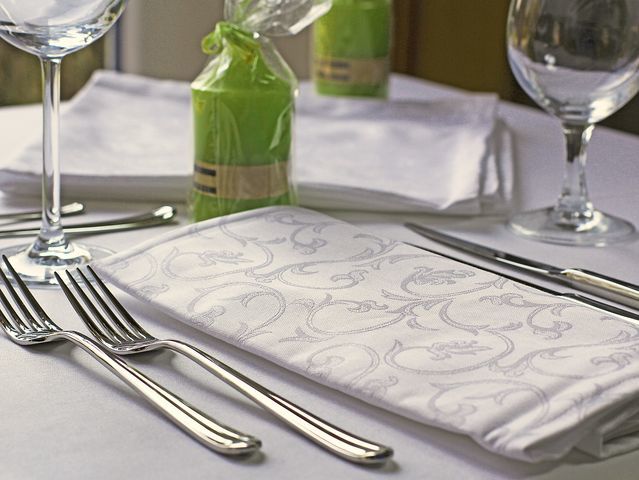 terns in tablecloths are not bound to special fibers/fabrics, but are mostly made from mercerised cotton, less often from silk or chemical fibers. In the tablecloth-shop.libusch.de, you will exclusively find damask tablecloths made of pure 100 percent cotton or cotton-linen blends. The damask pattern in the fabric of damask tablecloths is created by alternating different atlas bindings. Most damask patterns can be found on plain fabrics and look very discreet. They are particularly visible with oblique incidence of light. Especially table linen with an elaborate damask pattern looks very noble and stylish. Among the most important patterns that have always adorned damask tablecloths count floral elements and motifs, especially flowers, blossoms and leaves, which give tablecloths a fresh and delicate elegance. For this you also see the matching article damask at Wikipedia.
terns in tablecloths are not bound to special fibers/fabrics, but are mostly made from mercerised cotton, less often from silk or chemical fibers. In the tablecloth-shop.libusch.de, you will exclusively find damask tablecloths made of pure 100 percent cotton or cotton-linen blends. The damask pattern in the fabric of damask tablecloths is created by alternating different atlas bindings. Most damask patterns can be found on plain fabrics and look very discreet. They are particularly visible with oblique incidence of light. Especially table linen with an elaborate damask pattern looks very noble and stylish. Among the most important patterns that have always adorned damask tablecloths count floral elements and motifs, especially flowers, blossoms and leaves, which give tablecloths a fresh and delicate elegance. For this you also see the matching article damask at Wikipedia.
Decanting
Decanting is the careful pouring off, of a liquid from the sediment, such as red wine from the deposit.
Digestif
A digestif is a digestive spirit after a meal.
Dinner
Dinner (also called evening meal, tea or supper) is a meal of any kind taken in the late hours of the day. In the restaurant, large gastronomy napkins (dinner napkins) measuring 50x50cm are used for dinner, which are laid at the same time as the gastronomy tablecloth.
Entremetier
The entremetier is a cook who is responsible for the preparation of side dishes.
Fingerfood
Finger food refers to small bites that are handed from the plate together with a cocktail napkin to the hand.
Flambéing
Flambéing is the pouring of alcohol over food and the subsequent burning of the alcohol to refine the taste of food.
Flying Buffet
Flying Buffet means the serving of starters, main course and dessert in the form of small appetizers on plates. This is what the service personnel are for. As a rule, small catering napkins are served with the appetizers.
Garde manager
In the gastronomy and hotel business, a Garde manger is a cook who is responsible for the cold kitchen.
Garnish
Garnishing means the decoration of food and drinks, for example cocktails.
Fabric
 In tablecloth vocabulary, fabric is the term used to describe manually or machine-made products that come from a weaving mill, e. g. cloth, velvet, linen, damask and other textile products with at least two right-angled crossed thread systems. The threads that run lengthwise in tablecloths and fabric napkins are generally called warp or warp threads, the cross threads are called weft or weft threads. The threads are connected to each other in a cross hair in different rhythms. In order to achieve the greatest possible strength of a fabric and thus of a tablecloth, the warp and weft threads are woven as densely as possible. This gives, for example, a high-quality tablecloth a pleasantly firm and non-slip materiality, which then leads to a longer service life of the tablecloth.
In tablecloth vocabulary, fabric is the term used to describe manually or machine-made products that come from a weaving mill, e. g. cloth, velvet, linen, damask and other textile products with at least two right-angled crossed thread systems. The threads that run lengthwise in tablecloths and fabric napkins are generally called warp or warp threads, the cross threads are called weft or weft threads. The threads are connected to each other in a cross hair in different rhythms. In order to achieve the greatest possible strength of a fabric and thus of a tablecloth, the warp and weft threads are woven as densely as possible. This gives, for example, a high-quality tablecloth a pleasantly firm and non-slip materiality, which then leads to a longer service life of the tablecloth.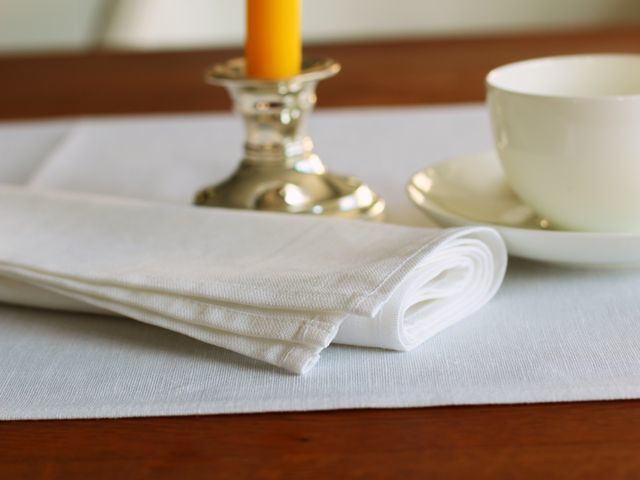
Half linen
In connection with tablecloths or napkins, half-linen means smooth or patterned fabrics consisting of flax and cotton yarns, each in warp or weft. The proportion of linen used for half-linen must be at least 40 per cent, which is the standard for half-linen tablecloths.
Hand napkin
A hand napkin (as opposed to a mouth napkin) is used by waiters in the catering industry for hot plates; otherwise it is worn on the left forearm.
Hemstitch
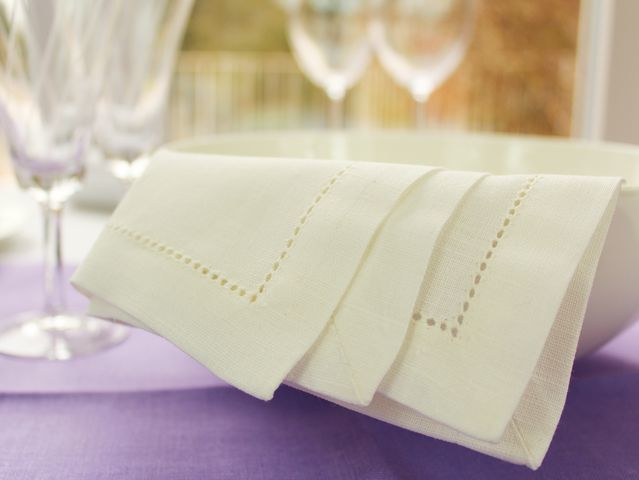 For many tablecloths and napkins hemstitches are used. A hemstitch is a decorative seam in fabrics, such as tablecloths or fabric napkins, which is created by pulling out warp and weft threads. For tablecloths, linen fabrics are particularly suitable for hemstitches. For a hemstitch, pull out two to eight threads in only one direction. The subsequent overstitching of the exposed thread webs results in a wide variety of patterns, depending on how the thread webs are bundled or plugged. Linen embroidery thread or a cotton embroidery thread can be used as embroidery thread. For simple hemstitches, the thickness of the embroidery thread should be approximately equal to the thickness of the fabric thread. Hemstitch tablecloths and hemstitch napkins are so popular because they look very classy and add elegance to any banquet table.
For many tablecloths and napkins hemstitches are used. A hemstitch is a decorative seam in fabrics, such as tablecloths or fabric napkins, which is created by pulling out warp and weft threads. For tablecloths, linen fabrics are particularly suitable for hemstitches. For a hemstitch, pull out two to eight threads in only one direction. The subsequent overstitching of the exposed thread webs results in a wide variety of patterns, depending on how the thread webs are bundled or plugged. Linen embroidery thread or a cotton embroidery thread can be used as embroidery thread. For simple hemstitches, the thickness of the embroidery thread should be approximately equal to the thickness of the fabric thread. Hemstitch tablecloths and hemstitch napkins are so popular because they look very classy and add elegance to any banquet table.
Jaquard weaving
Many tablecloths can also be found under the name Jacquard. Jacquard weaving is a weave named after J. M. Jaquard (1752-1834) with a complicated and elaborate pattern. The tablecloth motifs shown stand out against each other due to the contrast between the warp and weft atlas as well as different light reflections. The special weaving system automatically controls the individual warp threads in tablecloths for pattern formation. Jacquard is used, for example, for damask or brocade.
You can also see the matching article Jacquard Weaving at Wikipedia.
Linen
Besides cotton, linen is one of the most popular tablecloth fabrics and has experienced a real boom in the textile sector in recent years. Flax or linen fibre is a bast fibre and is obtained from the stems of the flax plant. In contrast to cotton, linen fibres form so-called bundles 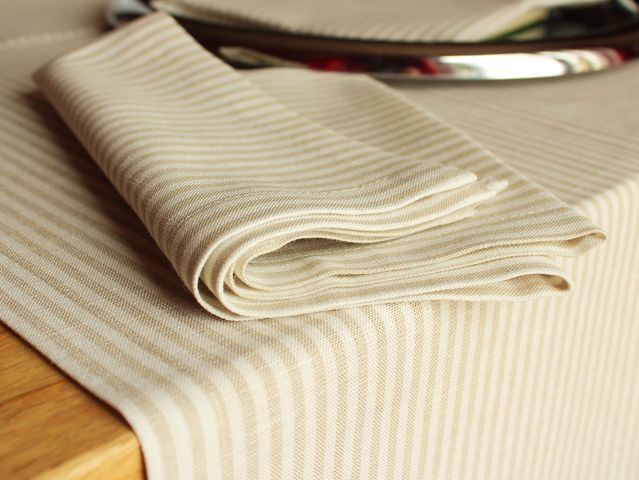 which consist of unconnected individual fibres. Linen is usually woven in the classic linen weave, but jacquard and other weave types are also very common in tablecloths. The linen fibre is easily separable and finely spinnable, making it suitable not only for table linen but also for clothing. In addition, linen is lint-free and less susceptible to dirt and bacteria, the fibre is bactericidal and antistatic due to its natural origin. Linen has a high tensile strength, is inelastic and therefore prone to creasing. However, the tear resistance makes the linen very durable and long-lasting; this is a good reason for many people to buy linen tablecloths. Linen tablecloths can maintain their quality and texture unchanged for decades. It is not uncommon for (linen) tablecloths still coming from grandmother's linen closet to be so popular with young people. Linen tablecloths are astonishingly resistant to washing lyes, detergents and cooking laundry. If you do not appreciate the noble wrinkle effect of linen, you can iron and mangle linen tablecloths at high temperatures. The prerequisite for this is that the tissue is still moist. The tumble dryer, on the other hand, should not be used with linen tablecloths, as excessive and dry heat damages the fabric. You should also be careful when bleaching linen, full bleaching leads to a high weight loss! The dyeing of linen, on the other hand, is possible.
which consist of unconnected individual fibres. Linen is usually woven in the classic linen weave, but jacquard and other weave types are also very common in tablecloths. The linen fibre is easily separable and finely spinnable, making it suitable not only for table linen but also for clothing. In addition, linen is lint-free and less susceptible to dirt and bacteria, the fibre is bactericidal and antistatic due to its natural origin. Linen has a high tensile strength, is inelastic and therefore prone to creasing. However, the tear resistance makes the linen very durable and long-lasting; this is a good reason for many people to buy linen tablecloths. Linen tablecloths can maintain their quality and texture unchanged for decades. It is not uncommon for (linen) tablecloths still coming from grandmother's linen closet to be so popular with young people. Linen tablecloths are astonishingly resistant to washing lyes, detergents and cooking laundry. If you do not appreciate the noble wrinkle effect of linen, you can iron and mangle linen tablecloths at high temperatures. The prerequisite for this is that the tissue is still moist. The tumble dryer, on the other hand, should not be used with linen tablecloths, as excessive and dry heat damages the fabric. You should also be careful when bleaching linen, full bleaching leads to a high weight loss! The dyeing of linen, on the other hand, is possible.
Maître
In a catering establishment, a maître is the name given to the head of the restaurant. He not only determines the processes in the kitchen, but also decides on how to proceed. B. about the catering table linen in the hotel or Restaurant.
Mercerise
In the technical vocabulary for table linen and tablecloths, the term mercerizing refers to a well-known finishing process, which gives cotton fabrics a noble, silky and wash resisting sheen. In addition, mercerizing increases the dye absorption capacity, strength, elongation and elasticity of the tablecloths.
Mitred corner, envelope edge
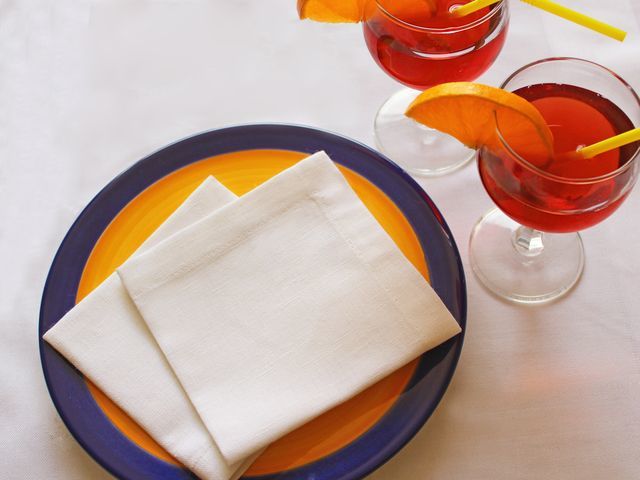 Mitred corners or envelope corners are the diagonal seams on hem corners as they are often used, for example, with tablecloths, napkins, table toppers or table runners. The diagonal seams run in the direction of the center of the tablecloth and look similar to the back of an envelope. The hem turn is usually several centimeters wide. The fabric corners are folded, cut and sewn diagonally from the lace to the hem width. Table linen with mitred corners or envelope corners looks very fine and clean and looks very noble. Such envelope corners are particularly popular for linen tablecloths and linen napkins. A letter corner can only decorate the corner seam of a square tablecloth, round or oval tablecloths never have mitred corners, they are hemmed all around.
Mitred corners or envelope corners are the diagonal seams on hem corners as they are often used, for example, with tablecloths, napkins, table toppers or table runners. The diagonal seams run in the direction of the center of the tablecloth and look similar to the back of an envelope. The hem turn is usually several centimeters wide. The fabric corners are folded, cut and sewn diagonally from the lace to the hem width. Table linen with mitred corners or envelope corners looks very fine and clean and looks very noble. Such envelope corners are particularly popular for linen tablecloths and linen napkins. A letter corner can only decorate the corner seam of a square tablecloth, round or oval tablecloths never have mitred corners, they are hemmed all around.
Molleton
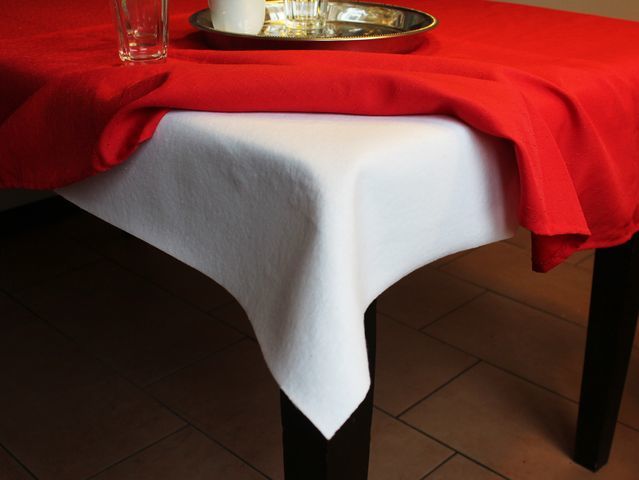 Molleton (molton) or table molton or tablecloth base is a light cotton fabric that is used as a base for catering tablecloths. The table covering becomes thicker, crockery noises are dampened by molton-pads under the catering tablecloth. Molton underlays also protect the table and, thanks to the upholstery, create a pleasant feeling when sitting at the table; the catering tablecloth also falls better on the edges on a table provided with a molton underlay.
Molleton (molton) or table molton or tablecloth base is a light cotton fabric that is used as a base for catering tablecloths. The table covering becomes thicker, crockery noises are dampened by molton-pads under the catering tablecloth. Molton underlays also protect the table and, thanks to the upholstery, create a pleasant feeling when sitting at the table; the catering tablecloth also falls better on the edges on a table provided with a molton underlay.
Napkins
Gastronomy napkins are made of fabric and usually measure 50x50 cm. Particularly popular are restaurant napkins with an atlas edge or restaurant napkins without any pattern. They are arranged on the plate of the guest, sometimes folded into beautiful figures. Gastronomy napkins are made of white, pure cotton, as they are exposed to many washing cycles. Gastronomy napkins must be boil and chlorine-proof, as stubborn stains often need to be treated.
Napkin folding
Folding gastronomy napkins into certain shapes is also called napkin folding. Known forms are bishop's mitre, a rose or a fan. Gastronomy napkins can also be folded as palm fronds or sails.
Panna Cotta
“Panna cotta” means boiled cream. It actually refers to a North Italian dessert that consists of cream, sugar, vanilla and gelatine. Panna cotta is usually prepared in hotels, restaurants and catering establishments with fruit sauces or boiled fruit.
Parfait
Parfait refers to semi-frozen ice cream and has become an integral part of today's upscale gastronomy.
Pâtissier
Pâtissier is in the gastronomy a kitchen confectioner who is too constant for the preparation of doughs, masses and sweet and ice cream dishes.
Pesto
Pesto is a spicy Italian sauce made from olive oil, basil, parmesan and garlic and chopped pine nuts.
Restaurant positions
The following positions are occupied in the catering, restaurant and hotel business: restaurant manager, headwaiter, chef de rang, demi chef de rang, commis de rank.
Saucier
A saucier is, in the gastronomy, a cook who is responsible for the preparation of sauces.
Setting the tables
If the table is provided with a table molleton and the catering tablecloth has been laid, the table can be set. The following sequence must be observed: Crockery - cutlery - glasses - catering napkins. Each place setting receives a place plate at first. Silver-plated place settings look particularly elegant, which, along with a white restaurant tablecloth, are part of the standard repertoire of an upscale restaurant and hotel business. For the table setting work, the chairs must be turned away from the table by 90°. This prevents unnecessary creases 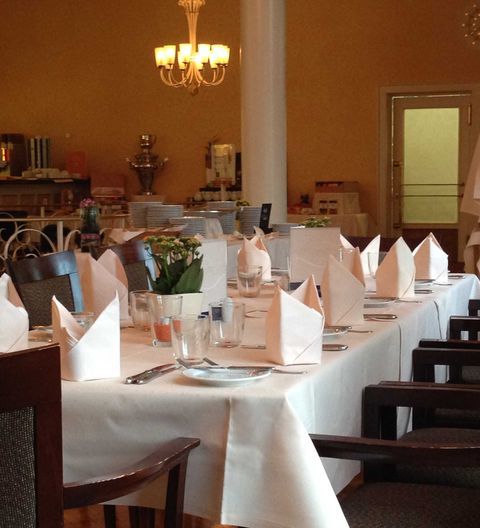 on the gastronomy tablecloth. Flower decorations and the candles are now being set up. Here a symmetrical arrangement looks best. The menu and the order of the dishes now determine the arrangement of the cutlery and the place setting. Silver cutlery is used in upscale gastronomy. The cutlery is arranged logically, oriented to the food. Eating is from the outside to the inside, but the cutlery is always laid from the inside to the outside. You start with the knife for the main course. The knife is located to the right of the burst plate, the cutting side to the left. The fork is positioned accordingly to the left of the plate with its tines pointing upwards. If no place mat is used, the knife and fork are always far enough apart for a plate to fit comfortably in between. If there is also a place setting on the opposite side of the table, the knife and fork should also face each other in a straight line. Next to the knife, the soupspoon is at the same height on the catering tablecloth. The cutlery should always be a finger width (approx. 1 cm or a thumb width) above the lower edge of the table. Now the knife and fork for the appetizer follow on the right resp. on the left. For the final dessert, the cutlery, which consists of a spoon and fork, is placed above the plate: The fork is placed across the plate with the handle pointing to the left, the spoon lies across the fork with the handle pointing to the right. Instead of a dessertspoon and fork, a coffee spoon and cake fork can of course be placed here, depending on the type of dessert intended. If you are serving cheese for dessert, the dessert knife with the handle to the right and the fork with the handle to the left is directly above the plate. If bread is included in the menu, there is a small plate for bread next to the left row of cutlery with a small knife for bread only. However, please note: Some dishes require special cutlery. These should be covered in advance according to their handling. Usually the tongs are arranged on the left, for example lobster or snail tongs. Special forks, such as lobster, snail, oyster and fondue forks are placed to the right of the plate. Glasses follow. There is a suitable glass for every drink. The glasses are laid on the right side above the cutlery according to the sequence of drinks. The glass for the first drink is placed outside right. No more than four glasses in total should be laid. Bellied style glasses are used for red wine, white wine is served in smaller glasses so that it can always be enjoyed chilled. In addition to wine glasses, a water glass should also always be laid. If sparkling wine is to be drunk, champagne goblets are preferable to champagne glasses, as they retain the carbon dioxide longer. In upscale gastronomy, the gastronomy napkin in the size 50x50 cm is always served in addition to the gastronomy tablecloths. The slightly strengthened gastronomy napkins made of fabric are placed on the plate or if the first course is already there, left of the left row of cutlery or on the bread plate. They can also be attractively folded into figures such as a bishop's miter or fan. Now the meal can begin.
on the gastronomy tablecloth. Flower decorations and the candles are now being set up. Here a symmetrical arrangement looks best. The menu and the order of the dishes now determine the arrangement of the cutlery and the place setting. Silver cutlery is used in upscale gastronomy. The cutlery is arranged logically, oriented to the food. Eating is from the outside to the inside, but the cutlery is always laid from the inside to the outside. You start with the knife for the main course. The knife is located to the right of the burst plate, the cutting side to the left. The fork is positioned accordingly to the left of the plate with its tines pointing upwards. If no place mat is used, the knife and fork are always far enough apart for a plate to fit comfortably in between. If there is also a place setting on the opposite side of the table, the knife and fork should also face each other in a straight line. Next to the knife, the soupspoon is at the same height on the catering tablecloth. The cutlery should always be a finger width (approx. 1 cm or a thumb width) above the lower edge of the table. Now the knife and fork for the appetizer follow on the right resp. on the left. For the final dessert, the cutlery, which consists of a spoon and fork, is placed above the plate: The fork is placed across the plate with the handle pointing to the left, the spoon lies across the fork with the handle pointing to the right. Instead of a dessertspoon and fork, a coffee spoon and cake fork can of course be placed here, depending on the type of dessert intended. If you are serving cheese for dessert, the dessert knife with the handle to the right and the fork with the handle to the left is directly above the plate. If bread is included in the menu, there is a small plate for bread next to the left row of cutlery with a small knife for bread only. However, please note: Some dishes require special cutlery. These should be covered in advance according to their handling. Usually the tongs are arranged on the left, for example lobster or snail tongs. Special forks, such as lobster, snail, oyster and fondue forks are placed to the right of the plate. Glasses follow. There is a suitable glass for every drink. The glasses are laid on the right side above the cutlery according to the sequence of drinks. The glass for the first drink is placed outside right. No more than four glasses in total should be laid. Bellied style glasses are used for red wine, white wine is served in smaller glasses so that it can always be enjoyed chilled. In addition to wine glasses, a water glass should also always be laid. If sparkling wine is to be drunk, champagne goblets are preferable to champagne glasses, as they retain the carbon dioxide longer. In upscale gastronomy, the gastronomy napkin in the size 50x50 cm is always served in addition to the gastronomy tablecloths. The slightly strengthened gastronomy napkins made of fabric are placed on the plate or if the first course is already there, left of the left row of cutlery or on the bread plate. They can also be attractively folded into figures such as a bishop's miter or fan. Now the meal can begin.
Shrinkage
In the tablecloth vocabulary, the shrinking process of brand-new tablecloths during washing is referred to as shrinkage. Depending on the quality of the table linen, the gap is 5-8 percent. This should be taken into account when choosing the size of a tablecloth.
Tablecloths Gastronomy
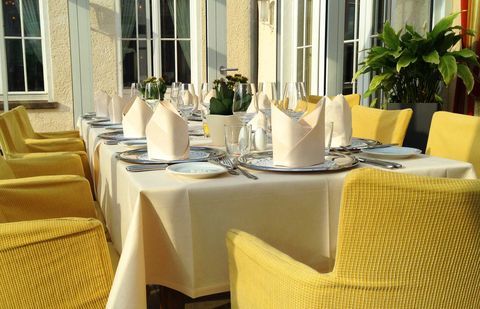 A tablecloth is a piece of cover adapted to the shape of the table and woven from textiles or made of plastic. Tablecloths are mainly used for three reasons: firstly, for design reasons, because tablecloths shape the appearance of a living space and contribute to well-being; secondly, to protect the table from dirt and wear and tear and thirdly, to cover an inferior table or its surface.
A tablecloth is a piece of cover adapted to the shape of the table and woven from textiles or made of plastic. Tablecloths are mainly used for three reasons: firstly, for design reasons, because tablecloths shape the appearance of a living space and contribute to well-being; secondly, to protect the table from dirt and wear and tear and thirdly, to cover an inferior table or its surface.
Tablecloths sizes / which tablecloth size do I need?
You can determine the optimum size of a tablecloth by taking the size of the tabletop and adding an overhang of approx. 20cm to max. 30cm on each side. This rule of thumb guarantees you a suitable tablecloth that is not too short and also not too long. If you choose a larger overhang, please consider the legroom of your guests! However, when calculating the size of a tablecloth, you should also take into account the shrinkage of the tablecloth during the first wash. This is about 5-8 percent. Our topics page, which explains in detail how to determine the right tablecloth size, can be found here.
Textile
A textile is a flexible material that consists of a composite of fibers, such as gastronomy tablecloths, gastronomy centrepieces, table runners or gastronomy napkins. A fabric or cloth, on the other hand, is a material that forms a so-called textile surface by weaving, knitting or otherwise connecting fibres.
Two-ply
Two-ply is used to describe twisted yarns. This refers to two- or multi-threaded yarns that are twisted together and only then woven. As a result, full-twist fabrics, such as those used in restaurant tablecloths and napkins, have a particularly high durability, optimum washing behaviour and, as a result, a long service life. Gastronomy tablecloths, in particular, are usually made of cotton two-ply, as they have to be particularly hardwearing. Our tablecloths are made of two-ply as well.
Yarn
Twisted yarns are produced by twisting two individual yarns together in the weaving mill. This considerably increases the strength of the woven fabric of a gastronomy tablecloth and improves the evenness of the woven fabric.
Warp
In connection with gastro tablecloths, warp or warp threads are the threads running in the longitudinal direction of the fabric, for example of a tablecloth.
Weft
Weft or weft threads are threads in tablecloths or fabric napkins running in the transverse direction of the fabric.
